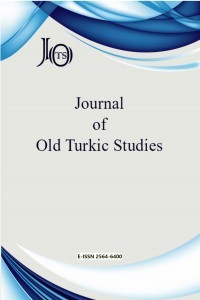İslam Öncesi Türk Metinlerinde ‘Kız’ ve ‘Kadın’
From seventh and eighth centuries to eleventh century, in the historical period of Pre-Islamic Turkish language and literature, the words for the concepts ‘girl’ and ‘woman’ used in the texts belonging to Old Turkic, the language of the ancient texts of Turkish language are analysed in this work in terms of lexicological and etymological point of view. Glossary entries corresponding the meaning of the concepts ‘girl’ and ‘woman’ are defined and based on lexical sources via demonstrating the usage of them in the texts. Consequently, the area of the concepts of ‘girl’ and ‘woman’ in Old Turks are researched through analysed glossary relevant to culture. Also the cultural background loaded by the semantic structure of the words meaning ‘girl’ and ‘woman’ is emphasised in the ancient literal works of Turkish language such as Turkic inscriptions, first folk poetry examples, documents, records etc.
Anahtar Kelimeler:
Pre-Islamic Turkic, historical texts, girl, woman, the area of concept
‘Girl’ and ‘Woman’ in the Pre-Islamic Turkic Texts
From seventh and eighth centuries to eleventh century, in the historical period of Pre-Islamic Turkish language and literature, the words for the concepts ‘girl’ and ‘woman’ used in the texts belonging to Old Turkic, the language of the ancient texts of Turkish language are analysed in this work in terms of lexicological and etymological point of view. Glossary entries corresponding the meaning of the concepts ‘girl’ and ‘woman’ are defined and based on lexical sources via demonstrating the usage of them in the texts. Consequently, the area of the concepts of ‘girl’ and ‘woman’ in Old Turks are researched through analysed glossary relevant to culture. Also the cultural background loaded by the semantic structure of the words meaning ‘girl’ and ‘woman’ is emphasised in the ancient literal works of Turkish language such as Turkic inscriptions, first folk poetry examples, documents, records etc.
Keywords:
Pre-Islamic Turkic, historical texts, girl, woman, the area of concept,
___
- ALYILMAZ, S., ALYILMAZ, C. (2014). “Eski Türk Kadın Heykellerinin Düşündürdükleri”, Uluslararası Türkçe Edebiyat Kültür Eğitim Dergisi, 3/4: 1-33.
- ARAT, R. R. (1932). Zur Heilkunde der Uiguren II, Berlin (Aus: SPAW. Phil.-hist. Kl. 1932: 22, 401-448)
- ARAT, R. R. (2007). Eski Türk Şiiri, Ankara: Türk Tarih Kurumu Yayınları.
- AYDIN, E. (2006). “Osman Fikri Sertkaya ve Türk Runik Metinleri”, Electronic Journal of Oriental Studies, XI/10: 1-9.
- AYDIN, E. (2007). Şine Usu Yazıtı, Çorum: Karam Yayınları.
- BERBERCAN, M. T. (2013). Çağatayca Gülistan Tercümesi (Giriş-Gramer-Metin-Notlar-Dizin-Tıpkıbasım), Ankara: Hâkim Yayınları.
- CLAUSON, Sir G. (1960). Sanglax: A Persian guide to the Turkish language by Muhammad Mahdī Xān, Facsimile text with an introduction and indices, London: Luzac.
- CLAUSON, Sir G. (1972). An Etymological Dictionary of Pre-Thirteenth Century Turkish, Oxford: Oxford University Press.
- ERCİLASUN, A. B.; Z. AKKOYUNLU (2014). Kâşgarlı Mahmud: Dîvânu Lugâti’t-Türk, Giriş-Metin-Çeviri-Notlar-Dizin, Ankara: Türk Dil Kurumu Yayınları.
- ERGİN, M. (2002). Orhun Abideleri, İstanbul: Boğaziçi Yayınları.
- ESİN, E. (1985). “Kotuz: İkinci Kök-Türk Sülalesinin Tamgası”, Erdem, 1: 125-131.
- GÜNDÜZ, A. (2012). “Tarihî Süreç İçerisinde Türk Toplumunda ve Devletlerinde Kadının Yeri ve Önemi”, The Journal of Academic Social Science Studies, 5/5: 129-148.
- KARAHAN, Akartürk (2006). “Tarihî Türk Dilinin Söz Varlığına Katkılar: Kadınla İlgili Kelimeler Üzerine”, Bilkent Üniversitesi I. Uluslararası Büyük Türk Dili Kurultayı Bildirileri, Ankara: 1-12.
- KAYA, C. (1994), Uygurca Altun Yaruk, Giriş, Metin ve Dizin, Ankara: Türk Dil Kurumu Yayınları.
- LESSING, F. D. (1960). Mongolian-English Dictionary, Berkeley-Los Angeles: University of California Press.
- LEVİTSKAYA, L. S. et al (1997). Etimologiçeskiy Slovar’ Tyurkskih Yazıkov 5, Obşçetyurkskiye i Mejtyurkskiye Leksiçeskiye Osnovı Na Bukvı ‘K’, ‘Қ’, Moskova.
- MAHMUDOV, K., G. MUSABAYEV (1954). Kazaksko-Russkiy Slovar’, Alma-Ata: Akad. Nauk Kazahskoy SSR.
- MANDALOĞLU, M. (2013). “İslamiyetten Önce Türklerde Aile Hukuku”, Selçuk Üniversitesi Türkiyat Araştırmaları Dergisi, 3: 133-159.
- MÜLLER, F. W. K. (1908). Uigurica [I], 1. Die Anbetung der Magier, ein christliches Bruchstück; 2. Die Reste des buddhistischen “Goldglanz–sūtra”, Ein vorläufiger Bericht, Berlin 1908 (Abhandlungen der Königlich Preußischen Akademie der Wissenschaften. Phil.–hist. Cl. 1908: 2).
- MÜLLER, F. W. K. (1911). Uigurica II, Berlin 1911 (Abhandlungen der Königlich Preußischen Akademie der Wissenschaften. Phil.–hist. Cl. 1910: 3).
- MÜLLER, F. W. K. (1911). Uigurica III, Uigurische Avadāna-Bruchstücke (I-VIII), Berlin. (APAW. Phil.-hist. Kl. 1920: 2)
- ÖZDARICI, Ö. (2011). “Dîvânü Lûgati’t-Türk’te Kadın ve Kadına İlişkin Unsurlar”, Kırıkkale Üniversitesi Sosyal Bilimler Dergisi, 1/1: 127-156.
- RÄSÄNEN, M. (1969). Versuch eines etymologischen Wörterbuchs der Türksprachen, Helsinki: Suomalais-Ugrilainen Seura.
- SERTKAYA, O. F. (1980). “Göktürk Tarihinin Meseleleri: Tonyukuk Abidesi Üzerine Üç Not: I. Tonyukuk Abidesinin İlk Satırı; II. ‘Çölgi (A)z (e)ri mi? – Çöl[l](ü)g iz (e)ri mi?; III. Tonyukuk Abidesindeki kız koduz Sıfat Tamlaması Üzerine”, Türkiyat Mecmuası, 19: 165-182.
- SEVİNÇ, N. (1987). Eski Türklerde Kadın ve Aile, İstanbul: Türk Dünyası Araştırmaları Vakfı Yayınları.
- TEKİN, T. (1994). Tunyukuk Yazıtı, Ankara: Simurg Yayınları.
- TEKİN, T. (2004). Irk Bitig (Eski Uygurca Fal Kitabı), Ankara: Öncü Kitap.
- TEKİN, T. (2008). Orhon Yazıtları, Ankara: Türk Dil Kurumu Yayınları.
- TEKİN, T. vd. (1995). Türkmence-Türkçe Sözlük, Ankara: Simurg Yayınları.
- TURAN, O. (1969). Türk Cihan Hâkimiyeti Mefkûresi I, İstanbul: Turan Neşriyat Yurdu.
- USEEV, N. (2012). “Köktürk Harfli Yenisey Yazıtlarındaki Kadını Bildiren Kelimelerin Anlamına Göre Eski Türklerde Kadın İmajı”, Dil Araştırmaları, 11: 57-66.
- YAKUT, E. (2002). “Eski Türklerde Hukuk”, Anadolu Üniversitesi Edebiyat Fakültesi Dergisi, 1/3: 401-426.
- YAZICI, Ş. S. (2013). “Orhun Yazıtlarında Kadınla İlgili Söz Varlığı”, Uluslararası Türk Dili ve Edebiyatı Kongresi (17.05.2013-19.05.2013, Bosna Hersek), Bildiri Kitabı, C. II, Ed. M. TEKCAN, International Burch University, Sarajevo: 393-402.
- Yayın Aralığı: Yılda 2 Sayı
- Başlangıç: 2017
- Yayıncı: Erdem UÇAR
